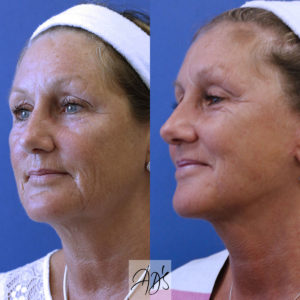WHY CONSIDER FACELIFT SURGERY
Why consider facelift surgery
Ageing is inevitable, and is most visible on the face, probably has the most psychological and social impact in todays society. These external changes often do not reflect our internal spirit and persona. Rhytidectomy, or a facelift, as it is commonly called, is an operation that addresses these concerns to a variable degree and helps to restore some of the changes related to ageing.
Am I suitable for surgery
A facelift is safe when performed in the right setting. There is no ideal age group in facelift surgery, but good general health including psychological stability and realistic expectations are prerequisites.
What result can I expect from surgery
A facelift improves the appearance of the face by reducing deep wrinkles, jowls and folds. The removal of excess fat and skin in the lower face and neck gives a better definition to the cheeks and re-contours the jawline and neck.
Limitations of facelift surgery
A facelift improves the general facial appearance to a variable degree, but not completely remove wrinkles, skin folds, jowls or excess skin from the neck (double chin), nor will it reverse the aging process. It does not get rid acne scars or pigmentation or discolouration such as age spots. It will not halt the ageing process.
Consultation
During your consultation with Mr D’Souza all your cosmetic concerns will be addressed in detail. The skin and structure of the face will be examined and discussed. Digital photographs are used to aid this process. Individual risks – general health, anaesthetic risks, risks of poor healing and unfavourable scars, effects of smoking, bleeding tendencies will be assessed. Both mental and emotional attitudes will also be considered because a realistic attitude is crucial to the success of the surgery.
Special considerations
These include skin type, ethnic background, degree of skin elasticity and volume loss, basic bone structure and individual healing etc. Adjunctive procedures such as chin and cheek augmentation, fat transfer, liposuction, laser resurfacing will be considered. Hairline pattern and previous scars will affect the outcome and will be discussed.
Types of facelifts
It is common practice to use terminology as “French lift, Mini lift, S lift, lunchtime lift etc. to name a few. All these are a spectrum of facelift procedure, and I urge you not be misguided by such terminology. The facelift procedures should be individually tailored and varies accordingly. Therefore the basic facelift technique is altered to achieve an optimal result. In a nutshell do not be confused or enticed with terminology.
How is the surgery performed?
Facelift is generally performed under a general anaesthetic though local anaesthetic with sedation may be used. Cuts vary depending on the individual patient and the desired outcome as demonstrated in the diagram, with scars that hide in natural skin creases. After lifting the skin the underlying muscle and tissues (SMAS) are tightened and secured at a required position. Excess skin is trimmed and the incision is closed with fine soluble stitches and/or clips. In some cases, a drainage tube may be inserted, which is usually removed the next day. A head and neck bandage is applied, which is removed generally after five to seven days following surgery.
What to expect post-operatively
Variable degree of pain, discomfort and bruising is to be expected. Tightness around the mouth, neck and ears is common. Stitches dissolve and come away in two to three weeks. Recovery usually takes two to three weeks following which normal activity may be resumed. Altered sensation of the ears is common which recovers in two to three months. Scars fade away with time. Avoiding direct sun for six months is recommended. Some relaxation of tissues is inevitable following surgery which relates to scar maturation and the on-going ageing process.
Potential complications of surgery
Complications are infrequent and include but not limited to bleeding, severe bruising, skin pigmentation, infection, unfavourable scarring, nerve damage, weakness of muscles, cosmetic irregularities, skin numbness, depression, cosmetic dissatisfaction etc. All these will be discussed during consultation.
IMPORTANT ADVICE
Please ask all questions you may have, and ascertain that your questions have been answered satisfactorily before you proceed to surgery.
Understand that this is lifestyle surgery and not an essential operation and should be considered a major intervention.
SUMMARY
| Procedure time | 3-4 Hours |
| General/Local anaesthetic | General preferred/local with sedation may be considered |
| Nights in hospital | 1 |
| Time off work | 2-3 weeks |
| Restricted routine | Up to 6 weeks |
| Back to routine: Sports/Gym/other etc. | 6 weeks |


